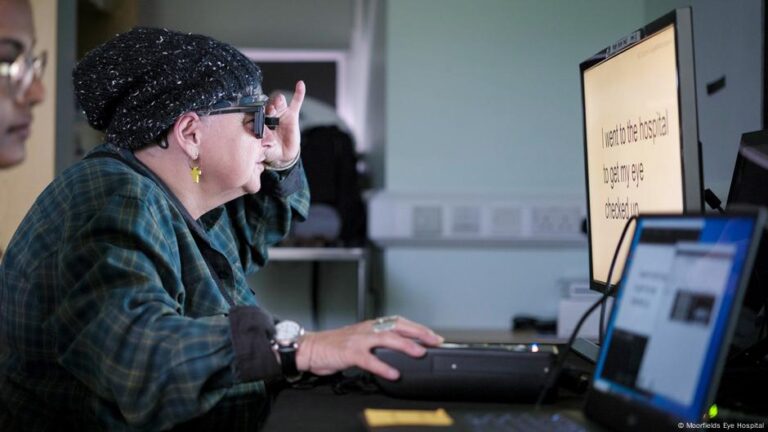Restoring vision — or at least improving it — for those with macular degeneration may soon be possible with a tiny chip and special glasses.
Together, the chip and eyeglasses have been shown to restore central vision for a type of eye disease, known as Age-related macular degeneration (AMD).
More than 80% of patients at trial sites across the United States, Germany, UK, Netherlands and Italy showed significant improvement in central vision following a year of monitoring.
With the implant, the patients were able to read numbers and words at home and could improve their reading ability by 25 letters — or five lines — on a standard eye exam chart.
The majority of participants, who were aged over 50 years, had their vision improved to about half as good as the standard 20/20 vision.
“It’s the first time ever where it has been shown that vision can be restored in a blind retinal area that is important for daily life,” Frank Holz, the study’s lead and the chair of ophthalmology at the University of Bonn, told DW.
As some people age, the macula, which is the part of the retina responsible for central vision, can deteriorate, leading first to vision blurring and then ongoing degeneration. Atrophic AMD is a leading cause of sight loss in older people, affecting at least five million people globally.
Implant helps to restore reading for people with atrophic AMD
A healthy eye can ‘see’ by receiving light from the outside world and converting it into electrical signals that are sent via the optic nerve into the brain for interpretation. Macular degeneration reduces the eye’s ability to do this.
The solution of implanting a pinhead-sized chip into the retina that can compensate for this deterioration inspired Daniel Palanker, an ophthalmologist at Stanford University, US. He collaborated with French eye expert Jose-Alain Sahel, based at the Pittsburgh School of Medicine, on developing the technology. They wanted to develop an implant that would do away with under-skin wires and appointed Holz to lead the latest trial.
But the chip is only one half of what they call the “PRIMA” system.
The other half is the specialized set of eyeglasses. They use a mounted camera to transmit visual data to the implant, which beams the data to a handheld processor for enhancement, and then receives higher-quality imagery back.
The images are converted to electrical impulses and utilize the remaining retinal cells to send the information to the brain.
“It requires, importantly in this disease, that the biocomputer, if you will — the [biological] wiring anterior to the chip — is still present,” said Holz, referring to still-functioning cells in the eye.
“If all cells from the retina were dead, the chip wouldn’t work at all. It [the implant] just replaces the photoreceptors and basically translates light into electric stimuli, which is what nature does in the eye with the retina.”
Collaboration and persistence reap reward
Sahel and Stanford-based Palanker had been working on separate technologies to try addressing the same problem when they met at a conference in 2012.
They decided to pool their resources to develop the implant, first with small studies with several patients and then this larger trial with more than 30.
But the current study nearly collapsed when the company developing PRIMA went out of business in 2024.
“I remember vividly the days not so long ago, when everything was just about to die at the time when the study was almost complete,” Sahel told DW. “There might have been a situation where you have a product that is working and there is no way to get it to the people.”
The developer has since been acquired by US company Science Corporation, which has taken over production and is seeking approval from the Food and Drug Administration (FDA) for use as a medical therapy in the US, and CE certification for use in Europe.
By conducting the trial across multiple countries and sites, the trial team is hopeful approval will be achieved in both regions.
“You want to demonstrate that the technology is not just limited to one or two very skilled surgeons,” Sahel told DW. “And that also patients from multiple backgrounds can benefit from it.”
It is an essential criterion for regulators that researchers show that difficult operations such as this implantation can be successfully performed by eye surgeons. While some adverse effects were reported in some patients, these cleared up by the end of the 12-month study period.
“Demonstrating that across 13 different sites and different surgeons there was some consistency in the results gives the ability to apply to get that distributed to more centers and more patients,” Sahel said.
Chip implantation: Not an easy operation
Sahel and Holz both highlighted that there are limitations to the new technology. While the operation to implant the chip had now been successfully performed by multiple surgeons around the world, they told DW it was not an easy operation.
“It’s a very complex surgery that needs good skills,” Sahel said.
The other challenge is the patient. There are logistical barriers that could affect patient suitability, such as their ability to repeatedly visit a clinic for post-surgery rehabilitation, and to have at-home support during this period.
Holz said an implant recipient must be willing to have ongoing post-surgery review, and be trained to use the camera and processor to be able to successfully use the implant.
That rehabilitation program currently takes around 12 months.
Edited by: Zulfikar Abbany


